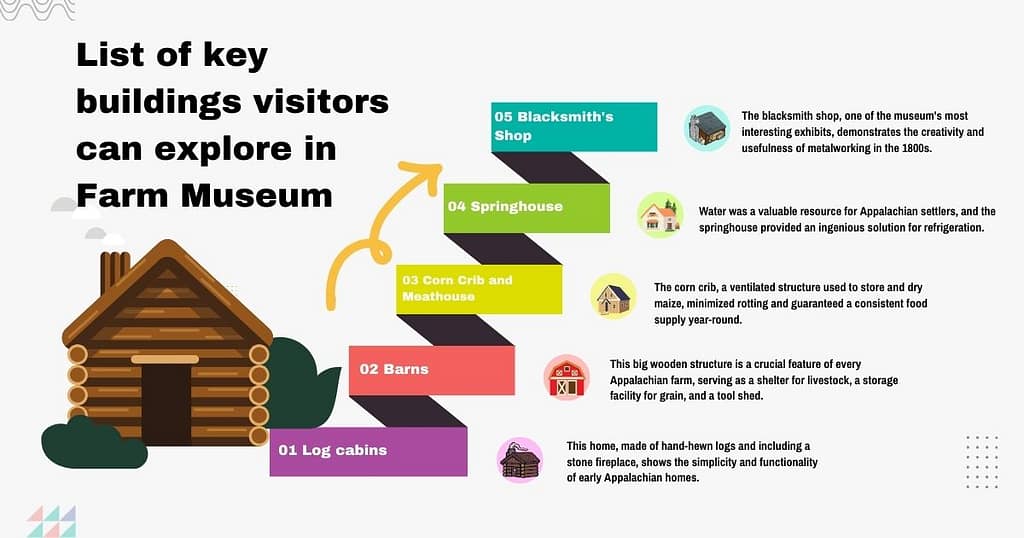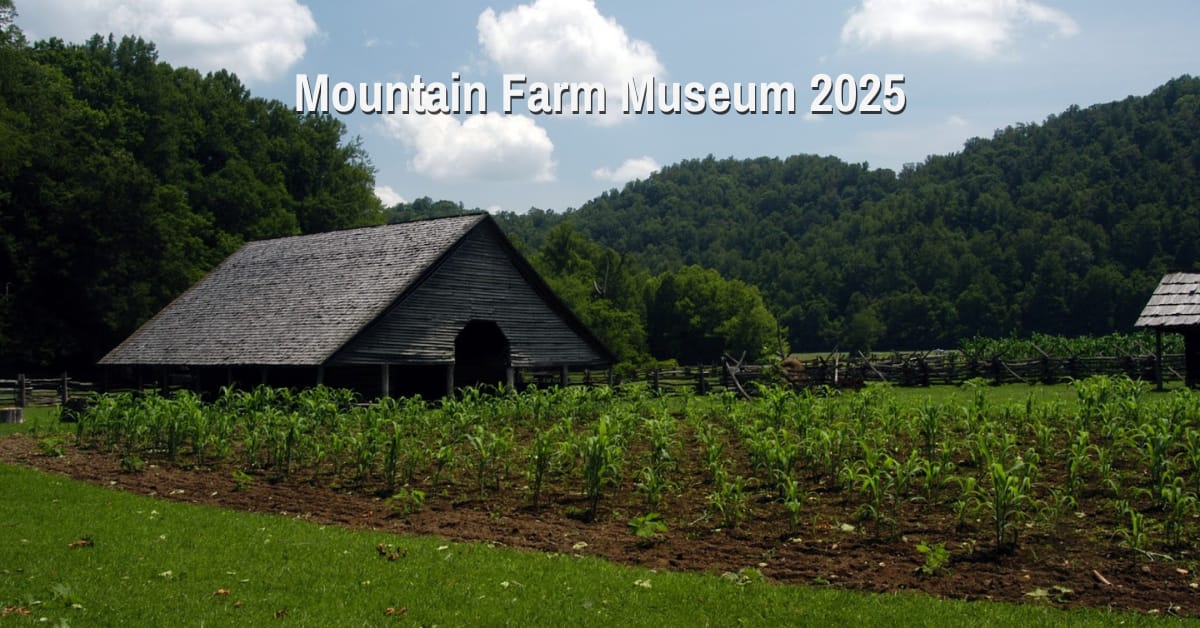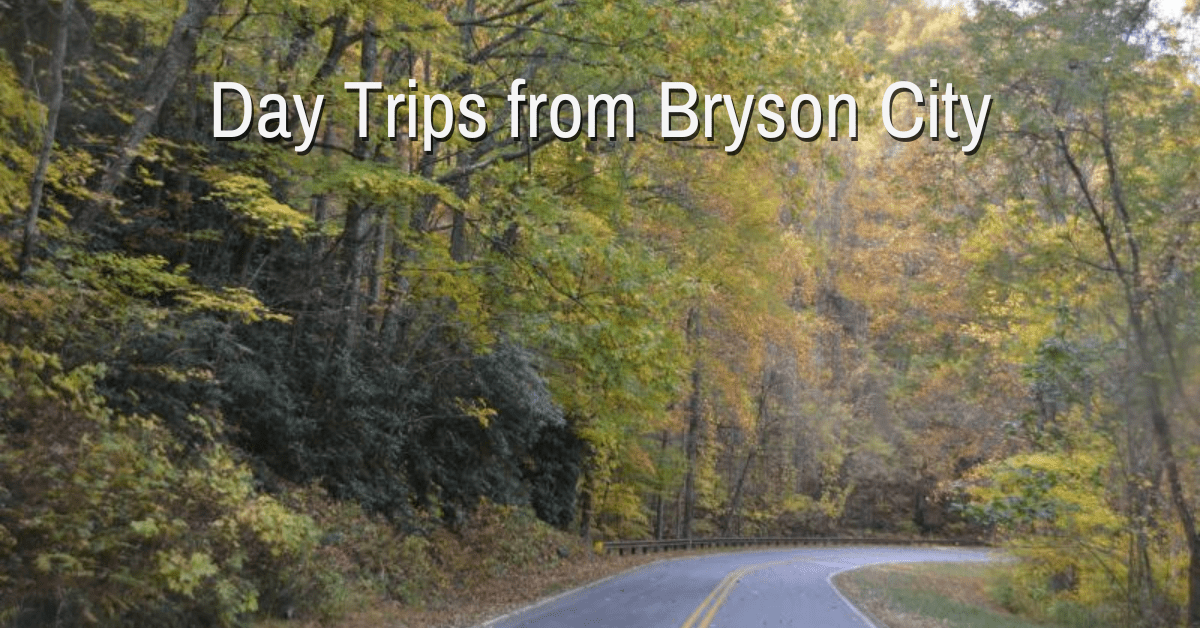The Mountain Farm Museum, located amid the magnificent Great Smoky Mountains National Park, offers visitors a rare view into nineteenth-century Appalachian life.
This outdoor museum keeps a collection of old farm buildings and celebrates the resilience and creativity of early Smoky Mountain inhabitants.
Located near Cherokee, North Carolina, and just a short drive from Bryson City, the museum is a must-see for history buffs, wildlife lovers, and families looking for an enriching experience.
Aside from its historical significance, the Mountain Farm Museum is an immersive educational experience. Visitors can explore log homes, barns, corn cribs, and a working blacksmith shop.
The Smoky Mountains’ magnificent backdrop adds to this open-air museum’s allure, resulting in a perfect blend of culture and natural beauty.
1. About Mountain Farm Museum North Carolina
The Mountain Farm Museum was founded to preserve and interpret the Southern Appalachian region’s agricultural legacy.
The structures seen here were transported from various locations of the park in the 1950s to form a complete picture of a 19th-century Appalachian farmstead.
These structures belonged to actual settlers who lived off the land, cultivating crops, rearing animals, and taking advantage of the Smokies’ plentiful natural resources.
Unlike many museums, which focus on a single homestead, this group of structures provides a more comprehensive view of how families adapted to the harsh mountain climate.
List of key buildings visitors can explore
Visitors to the Mountain Farm Museum will come across various well-preserved structures, each with their unique historical significance:

Log cabins
A classic log cabin from the late 1800s serves as the museum’s centerpiece.
- This home, made of hand-hewn logs and including a stone fireplace, shows the simplicity and functionality of early Appalachian homes.
- Inside, visitors can view period-appropriate furnishings such as a cast-iron stove, wooden furniture, and household items.
- The cabin’s arrangement portrays the lifestyle of self-sufficient mountain families who survived by farming, hunting, and handcrafting.
Barns
A visit to the barn sheds light on the agricultural methods of the time.
- This big wooden structure is a crucial feature of every Appalachian farm, serving as a shelter for livestock, a storage facility for grain, and a tool shed.
- Oxen, mules, and horses were frequently utilized for plowing and transportation.
- The barn also contained hay, maize, and other harvested products required to survive the hard mountain winters.
Corn Crib and Meathouse
Corn was a key crop for early settlers, providing both food for livestock and an important ingredient in daily meals.
- The corn crib, a ventilated structure used to store and dry maize, minimized rotting and guaranteed a consistent food supply year-round.
- Meat houses, also known as smokehouses, were used to preserve meats by smoking and curing.
- Without refrigeration, settlers relied on salt curing and smoke-drying to prevent meat spoilage and ensure their survival during the colder months.
Springhouse
Water was a valuable resource for Appalachian settlers, and the springhouse provided an ingenious solution for refrigeration.
- Using naturally cool spring water, this building kept dairy goods, meats, and other perishable foods fresh.
- A visit to the springhouse provides an intriguing glimpse into how settlers harnessed natural forces to make life simpler in an age before electricity.
Blacksmith’s Shop
The blacksmith shop, one of the museum’s most interesting exhibits, demonstrates the creativity and usefulness of metalworking in the 1800s.
- Blacksmiths were important members of the community, creating items such as horseshoes, nails, and farming implements.
- Occasionally, live demonstrations allow visitors to see traditional metalworking skills in action, bringing history alive.
2. Top Ways to Experience Mountain Farm Museum
There are several ways to immerse yourself in the history of Appalachian farm life at the Mountain Farm Museum:
Self-Guided Walking Tour
Walk through the museum at your speed, reading educational inscriptions about early settlement life and farming methods. This alternative allows tourists to take their time and absorb historical details without feeling rushed.
Seasonal Demonstrations
Visitors can see live demonstrations of traditional techniques like blacksmithing, woodworking, and sorghum milling throughout the year. These hands-on experiences foster a greater understanding of the resourcefulness and craftsmanship of early Appalachian pioneers.
Ranger-led programs
Join a trained park ranger on a guided tour that includes fascinating anecdotes and historical background. Rangers frequently tell details about daily living on an Appalachian farm, emphasizing the strength and resourcefulness of early mountain families.
Oconaluftee Visitor Center
Visit the Oconaluftee Visitor Center, which is located adjacent to the museum and houses more exhibits on the Smoky Mountains’ cultural and ecological heritage. You can find maps, information about hiking trails, and even a chance to see the region’s famous elk grazing nearby.
3. Travel Tips for Visiting Mountain Farm Museum
Planning a visit to the museum? Here are some ideas to improve your experience:
- Best Time of Year to Visit: Spring and fall provide moderate weather and beautiful landscapes, making them excellent for exploring both the museum and its surroundings.
- Plan Ahead: During high tourist seasons, the museum can get busy, so consider purchasing tickets ahead of time or visiting early to avoid crowds.
- Take your time: Allow at least 2-3 hours to enjoy the displays. If you’re particularly interested in history, you might want to set aside half a day.
- What to wear: Layering is vital in the mountains, where the weather can be unpredictable. Suitable hiking shoes or sturdy sneakers are advised. Sudden showers are usual in the highlands, so bring a light rain jacket or umbrella.
- Photography Tips: The farm’s rustic appeal is best caught in the early morning or late afternoon when the lighting enhances the historical mood.
- Wildlife Awareness: Keep a watch out for elk, which are frequently spotted grazing in the fields around the museum.
4. Best Places to Stay Near Mountain Farm Museum
After a day of experiencing history and environment, finding the appropriate place to unwind is crucial. Elk Hollow Resort in Bryson City is a fantastic hotel option that combines comfort and scenic beauty.
Why stay at Elk Hollow Resort?
- Nearby attractions include the Mountain Farm Museum. It’s just a short drive away, making it an ideal location for your Smoky Mountain adventures.
- Enjoy modern amenities including hot tubs and breathtaking mountain views.
- Elk Hollow Resort welcomes couples looking for a romantic retreat, families on vacation, and lone travelers looking for peace.
Special Offer: Book your stay directly through our website and get exclusive discounts on extended stays!
Conclusion | Mountain Farm Museum
The Mountain Farm Museum provides a unique glimpse into the past, allowing visitors to walk back in time and witness the tenacity of early Appalachian pioneers.
It’s a location that every traveler should see, thanks to its rich history, intriguing displays, and picturesque surroundings.
For an amazing Smoky Mountain escape, combine your museum visit with a peaceful stay at Elk Hollow Resort.
Exploring this lovely location will provide you with the ideal balance of history, nature, and comfort.
Ready to learn about Appalachian history? Book your stay at Elk Hollow Resort today and begin your Smoky Mountains experience!
Mountain Farm Museum FAQs
1. What is the Mountain Farm Museum?
The Mountain Farm Museum is an outdoor museum in the Great Smoky Mountains National Park. It showcases 19th-century Appalachian farm life with historic cabins, barns, and blacksmith shops.
2. Where is the Mountain Farm Museum located?
The museum is located near Cherokee, North Carolina, adjacent to the Oconaluftee Visitor Center, just a short drive from Bryson City.
3. What can visitors see at the Mountain Farm Museum?
Visitors can explore authentic farm buildings, including log cabins, barns, corn cribs, a blacksmith shop, and a springhouse. Seasonal demonstrations bring history to life.
4. Is there an admission fee for the Mountain Farm Museum?
No, admission to the Mountain Farm Museum is free. However, donations are appreciated to support park preservation.
5. What is the best time of year to visit the Mountain Farm Museum?
Spring and fall are ideal, offering pleasant weather and scenic mountain views. The farm’s rustic charm is enhanced by colorful foliage in the fall.
6. Are there guided tours available?
Yes, the museum offers ranger-led programs with historical insights and engaging anecdotes about 19th-century Appalachian farm life.
7. Can visitors see live demonstrations?
Yes, the museum frequently hosts live demonstrations of blacksmithing, woodworking, and traditional farming techniques, showcasing pioneer skills.
8. How long does it take to explore the Mountain Farm Museum?
Plan to spend 2-3 hours exploring the museum. If you enjoy history and demonstrations, consider allocating half a day.
9. Are pets allowed at the Mountain Farm Museum?
Yes, pets are allowed but must be kept on a leash at all times. Be sure to clean up after your pet.
10. Where can visitors stay near the Mountain Farm Museum?
Elk Hollow Resort in Bryson City is a nearby lodging option. It offers modern amenities, scenic mountain views, and easy access to the museum.



